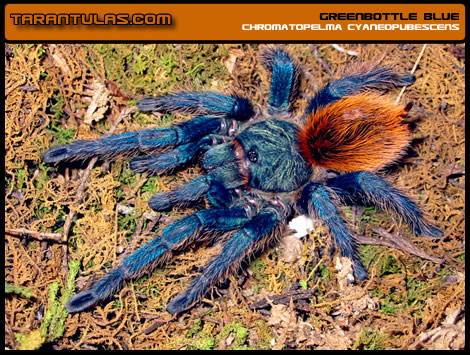Chromatopelma cyaneopubescens
© 2009-2010, Michael Jacobi and TARANTULAS.com
Common Name(s): Greenbottle Blue (often abbreviated as GBB)
Experience Level: Beginner
Range: northern coast of Venezuela (Paraguana peninsula)
Habitat: arid desert/grassland
Habits: terrestrial that lives in silken retreats in ground fissures or under ground cover among thorn scrub, grasses, and at the bases of succulents (agave, cactus)
Behavior: skittish/nervous species that will stay out in the open in captivity and create silk-lined resting places or tube-like retreats
Temperature & Humidity: warm [70-78°F] & very dry [30-50% RH]
Housing: simple terrestrial cage with plenty of ventilation (a plastic critter keeper style terrarium is excellent), dry substrate (commercial organic cactus soil mixes are excellent but dry coconut coir or 50/50 sphagnum peat moss/vermiculite mix are just as good), hiding place and very small water dish — extra care should be used when raising spiderlings as small containers typically used, such as vials or small jars with lids with small air holes, are too poorly ventilated (we use 16 oz. deli cups with insect cup style lids to raise young Greenbottles)
Captive Diet: crickets, superworms, grasshoppers, small roaches
Comments: This colorful species makes an excellent display tarantula. It's a bit fast and nervous to be considered "docile" in the sense of most Grammostola or Brachypelma, but it is not overly defensive and since it is also hardy and easy to care for it makes an excellent beginner species for those who prefer a hands-off terrarium pet. The key is keeping it dry as it is sensitive to any dampness whether cage moisture, air humidity, or poor ventilation. Remove any uneaten food immediately as even decaying crickets can cause excessive humidity in small poorly ventilated containers that spiderlings are often raised in. It is interesting that this species can do well in vertically oriented cages that would normally only be used for arboreals. We at TARANTULAS.com breed this species in the same tall acrylic cages that we use to breed Poecilotheria. The spiders like to climb an angled piece of cork bark and build a silk retreat a few inches off the substrate, which aids in keeping them away from any dampness.
Additional Info: Basic Tarantula Care | Raising Young Tarantulas
References
Bagaturov, M.F. 2007.
Hobby jewellery - Chromatopelma cyaneopubescens: First detailed breeding in captivity with notes on the species.
Journal of the British Tarantula Society 22(2): 56-65.
West, R.C. 2005.
Desert 'Blues'.
ARACHNOCULTURE 1(1): 22-28.
